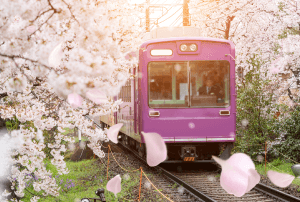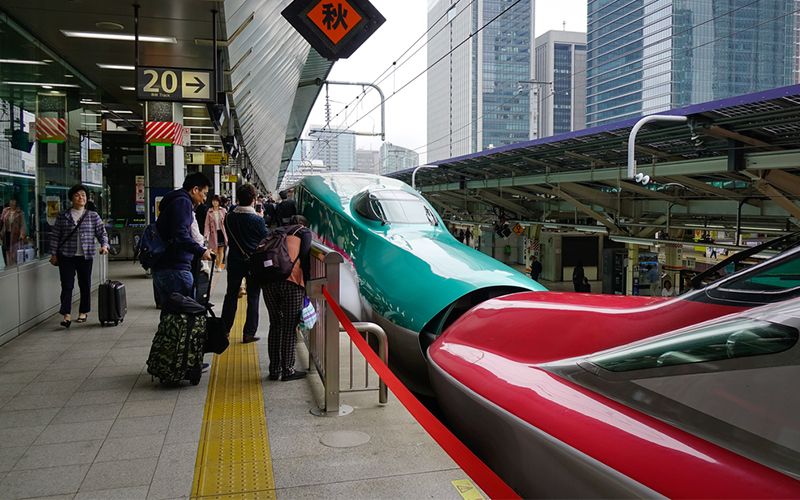Traveling around Japan using Shinkansen bullet trains is an absolute pleasure. They’re comfortable, convenient, luxurious, and above all, super-fast! However, at first, it can be difficult to know where and how to buy Shinkansen tickets.
Everyone wants to get the best value tickets possible, but without doing extensive research it can be tricky. This guide to Shinkansen tickets will explain the different types, where to buy them from, how to use them, and how you can save money by getting the best-value tickets.
Table of Contents
Shinkansen tickets types
To ride a Shinkansen, you need 2 types of tickets.
Firstly, you need a passenger ticket which indicates the car and seat numbers along with the destination station.
Secondly, you need an express ticket to ride Shinkansen trains (and other types of fast ‘express trains’).

Certain trains may use a single integrated ticket, but often you need both a passenger and express ticket to board your train. Train attendants routinely check for both types of tickets during the journey.
Read more: Japan train tickets guide
Shinkansen tickets prices
The price of a Shinkansen ticket is the sum of the base fare + Shinkansen supplement + seat reservation fee (if applicable) + green car fee (if applicable).
Both the base fare and a supplemental super-express surcharge increase with the distance you travel.
During peak season and super-peak season, a ¥200 or ¥400 surcharge is applied, while a ¥200 discount applies during the off-season.
An additional charge applies to reserved seats. Depending on the date of the journey, and whether it’s peak, regular or off-season, the seat reservation fee is either ¥330, ¥530, ¥730 or ¥930.
Additionally, a supplement applies to people riding in green cars (equivalent to first class). This increases with the distance traveled, too.
Some trains, such as Nozomi and Mizuho services, have an additional supplemental fee. This is not covered by the JR Pass, so you need to purchase a complementary ticket to ride these trains. However, the JR Pass fully covers all other services.
Below, we’ve provided a breakdown of the prices of some of the most popular routes on the Tokaido Shinkansen on Kodama and Hikari services. Keep in mind that fares can vary depending on time of year and various other factors.
| Route |
Adult ticket price |
Child ticket price |
| Tokyo to Nagoya |
¥10,560 |
¥5,280 |
| Tokyo to Osaka |
¥13,870 |
¥6,930 |
| Tokyo to Kyoto |
¥13,320 |
¥6,660 |
| Tokyo to Hiroshima |
¥18,380 |
¥9,190 |
| Osaka to Kyoto |
¥580 |
¥290 |
The prices indicated include the base fare + the super express surcharge and are for non-reserved seating in an ordinary car. You can find more information on the breakdown of the fees here.
Child discount
Children (under 12 years old) are entitled to a discount depending on how young they are. The different discounts for a child depending on age are as follows:
- Children 6 to 11 years old – Children in this age bracket pay 50% of the adult fare. Green car fees are still charged at full price.
- Young children (1 to 5 years old) – Up to 2 young children can travel for free when accompanied by an adult. Additional children, or young children that occupy a reserved seat, are charged the regular child’s price (50% of full fare).
- Infant (less than one year old) – Up to 2 infants can travel for free. The regular child fare (50% of full fare) applies if the child occupies a reserved seat, green car seat, or bed. In parties with more than 2 infants, only 2 may ride for free; tickets must be purchased for all additional children.
How and where to buy Shinkansen tickets
You can buy regular Shinkansen tickets from ticket counters or ticket machines.,
For Sanyo, Tokaido and Kyushu shinkansen tickets, you can buy online through the official website, SmartEx.
For JR East tickets, you can also use their online platform, Ekinet. These platforms also allow you to make seat reservations.
Here is a quick table showing some of the differences between these two platforms:
| Feature | Ekinet | SmartEX |
|---|---|---|
| Coverage | Covers JR East trains, including the Tohoku, Joetsu, and Hokuriku shinkansen. Also includes some JR Hokkaido services. Limited Express, Joyful Trains, and Narita Express tickets available. | Covers the Tokaido, Sanyo, and Kyushu shinkansen operated by JR West, JR Kyushu, and JR Central. |
| Languages | Available in English, French, Spanish, German, Chinese, and Thai. | Available in Japanese and English. |
| E-Tickets | Linked to IC card (Suica/Pasmo). Paper tickets also available. | QR code or IC card link. Paper tickets also available. |
| Ticket Collection | At JR East/Hokkaido stations. | Only at JR Central/West/Kyushu stations. |
Both of these platforms offer mobile apps that allow you to purchase tickets.
To take advantage of the multi-trip ticket, the Japan Rail Pass is available to order online in advance of your trip.

There are JR ticket offices at every major and most minor train stations throughout Japan. Credit cards are accepted at the vast majority of ticket offices. You need to provide the following information to buy a ticket:
- Number of passengers
- Journey date
- Departure station
- Destination station
- Regular or green car
- Reserved or non-reserved seat
For a seat reservation, you also need to provide the following additional information:
- Train name (e.g. Hikari)
- Train number
- Departure time
- Smoking or non-smoking
Also, in the JR offices you can always activate your JR Pass and make the related seat reservations.
You can use most ticket machines in English. The machines are very useful if you’re familiar with them, but they can be confusing. Not all machines are the same, as some only offer Shinkansen tickets, others only offer seat reservations, and some do not accept foreign credit cards.
How to use Shinkansen tickets
There are special Shinkansen gates at train stations for the bullet trains. You just need to slide both tickets at the same time into the gate to pass through.
You can then check the electronic timetables to find out which platform your Shinkansen train departs from.
If you have a non-reserved seat ticket, you can find where the non-reserved cars and wait in line.
If you have a reserved ticket, you can board your train.
Read more: Train travel in Japan
Single tickets vs JR Pass
If you’re planning to spend more than a few days in Japan, visit several parts of the country, and travel long distances, it may be more affordable to buy a Japan Rail Pass than several one-way tickets.
Sometimes one-way tickets aren’t worth it, especially if you’re making several trips on Shinkansen, local trains, or JR Group buses.
The Japan Rail Pass is also a practical option for easy travel, as this single, unlimited ticket means you don’t have to buy a ticket every time you want to use public transport.


If you're looking to extensively explore a specific area of Japan, choose one of the JR Regional Passes for unlimited travel within a designated region.
An alternative to the JR Pass are the regional passes offered by JR companies in different regions of Japan: a regional pass can be a great option if you’re only planning to extensively explore one specific area of the country.
